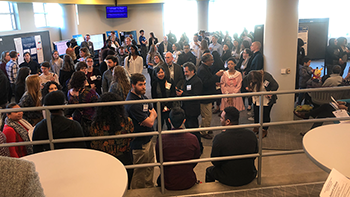Reconstruction of Gene Regulatory Network in Early Bovine Embryo
Description/Abstract/Artist Statement
Deciphering gene regulatory network (GRN) underlying cellular function is important. Not only does it lead to a better understanding of the fundamental mechanisms behind the high diversity in biological cells, but it also lays out the basis for potential intervention for desired cellular functions or treating diseases. Single-cell RNA sequencing (scRNA-seq) together with other high throughput sequencing techniques have made it possible to reconstruct the GRN at the systems level and in very fine detail. The algorithms constructing the GRNs are usually general enough to be applied to different species and thus used to make new discoveries rapidly. Currently, these methods have not yet been utilized on the bovine species, which has indications of being even more similar to the human developmental process at an embryonic level from the perspective of gene expression than the mouse. Using bovine data, we intend to take advantage of this connection between the bovine and human species to make discoveries that could provide meaningful results when studying the viability of in-vitro and in-vivo embryos at their various stages. With more data highlighting the differences in the gene expression between in-vitro and in-vivo fertilization, medical institutions will be better poised to offer healthy embryos to mothers and thus allow for more children to be born from these nonconventional methods. As a larger goal, medical institutions will be better suited to understand the embryonic process and thus diagnose health issues long before they would otherwise be diagnosed.
Faculty Advisor/Mentor
Jiangwen Sun
Presentation Type
Poster
Disciplines
Artificial Intelligence and Robotics
Session Title
Poster Session
Location
Learning Commons, Atrium
Start Date
2-8-2020 8:00 AM
End Date
2-8-2020 12:30 PM
Reconstruction of Gene Regulatory Network in Early Bovine Embryo
Learning Commons, Atrium
Deciphering gene regulatory network (GRN) underlying cellular function is important. Not only does it lead to a better understanding of the fundamental mechanisms behind the high diversity in biological cells, but it also lays out the basis for potential intervention for desired cellular functions or treating diseases. Single-cell RNA sequencing (scRNA-seq) together with other high throughput sequencing techniques have made it possible to reconstruct the GRN at the systems level and in very fine detail. The algorithms constructing the GRNs are usually general enough to be applied to different species and thus used to make new discoveries rapidly. Currently, these methods have not yet been utilized on the bovine species, which has indications of being even more similar to the human developmental process at an embryonic level from the perspective of gene expression than the mouse. Using bovine data, we intend to take advantage of this connection between the bovine and human species to make discoveries that could provide meaningful results when studying the viability of in-vitro and in-vivo embryos at their various stages. With more data highlighting the differences in the gene expression between in-vitro and in-vivo fertilization, medical institutions will be better poised to offer healthy embryos to mothers and thus allow for more children to be born from these nonconventional methods. As a larger goal, medical institutions will be better suited to understand the embryonic process and thus diagnose health issues long before they would otherwise be diagnosed.


